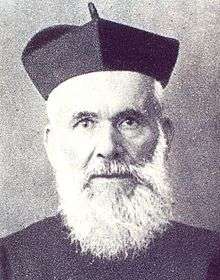Henri Lammens

Henri Lammens (1 Jul 1862 – 23 Apr 1937) was an Orientalist historian and Jesuit. He is most notable for his books on the early history of Islam. He wrote in French.
Education and career as a Jesuit
Born in Ghent, Belgium of Catholic Flemish stock, Henri Lammens joined the Society of Jesus in Beirut at the age of fifteen, and settled permanently in Lebanon. During his first eight years in Lebanon, Lammens mastered the Arabic language, as well as Latin, and Greek, and he studied philosophy at the Jesuit-run Saint Joseph University in Beirut. Between 1886 and 1891 he taught the Arabic language at the same university. His early published writings are on the subject of Arabic language. Starting in 1903 he taught Islamic history at the Oriental Studies Department at Saint Joseph University in Beirut. In 1907 he went to the Jesuit-run universities at Cairo and Alexandria in Egypt to do the same, and returned to Beirut in 1919. He also lived in Rome for a while.[1]
Lammens' writings on medieval Islam
He published a series of studies on the Umayyads and several on Pre-Islamic Arabia (including Etudes sur le regne du calife Omaiyade Mo'awia ler (1908), Le berceau de l'Islam; L'Arabie occidentale à la veille de l'Hegire (1914)), and on the history of Islam during the lifetime of the Prophet Mohammed (including Fatima et les filles de Mahomet; Notes critiques pour l'etude de la Sira (1912)). He contributed many articles to the first edition of the Encyclopaedia of Islam, as well as to various learned journals.
His contributions to the early history of Islam are considered influential among Western historians of Islam; and yet he has often been criticized for his skewed portrayal of some historical issues. It is acknowledged "that Lammens provided the study of the Sira with a new basis; and none would underestimate his contributions on the history of the Umayyads." Lammens was very well read in medieval Arabic writings, and he used this knowledge to good effect to produce evidence-based history reports. At the same time, however, he had underlying presuppositions that are prejudiced and bigoted against Islam. Also, throughout his years living in Lebanon and Egypt, in addition to a very pro-Christian bias, he had a "commitment to European imperialism and a belief in the superiority of Western civilization".[1] Numerous historians during his lifetime decried the islamophobic attitude contained in his books. At one point, Lammens proposed to write a book-length biography of the Prophet Muhammad, and the proposal was ruled out by his Jesuit Order superiors because of the extent of his anti-Islamic reputation.[1]
Other Historians' views of Henri Lammens
da:Frants Buhl, a biographer of the Prophet Muhammad, remarks:
- «dessen Belesenheit und Scharfsinn man bewundern muss, der aber doch oft die Objektivität des unparteiischen Historikers vermissen lässt.»[2]
- i.e. "[Lammens] whose erudition and acumen one must admire, but who often lacks the objectivity of an impartial historian."
Maxime Rodinson, a biographer of the Prophet Muhammad, characterized Lammens as follows:
- He... possessed a remarkable ability to lay hold of those living qualities communicated by the ancient texts along with a literary talent which enabled him to convey these to his readers... In addition, he was filled with a holy contempt for Islam, for its 'delusive glory', and 'lascivious' prophet." [3]
Louis Massignon criticized Lammens for 'misinforming' his readers with his 'far too cynical and disparaging study' of Hazrat Fatima.[4]
Other writings
Lammens was also a frequent contributor to the popular Beirut-based scholarly journal, al-Mashriq. In a review of the Maronite priest and scholar Fadl Allah Abu Halqa’s 1890 historical geography textbook, for instance, he critiqued ABu Halqa for his ignorance of the classical languages, including Greek, Hebrew and Syriac.[5]
Henry Lammens published one of the earliest in-depth pieces on Zionism in Arabic in 1899 in the journal al-Mashriq, titled “The Jews in Palestine and their Settlements.” He surveyed the existing Zionist settlements, dividing them into five categories: Jaffa and its surroundings, Jerusalem and its Surroundings, Safed and Bilad al-Bishara (i.e. the Galilee), Haifa and its surroundings, and the Hawran and Transjordan (‘Abr al-Urdunn). His tone was dry and detached, seemingly indifferent to the whole matter. He made no mention anywhere that the Jews were interested in establishing an independent government in Palestine. His only point of criticism was that the Jews had violated orders of the Sultan in establishing their colonies. His only source was a report published in the Istanbul-based, Journal of the Palestine Association.[6]
Works
(List incomplete)
- Islam: Beliefs and Institutions. An online review of this book is available.[7]
- The Age of Muhammad and the Chronology of the Sira
- Fatima and the Daughters of Muhammad (1912)
References
- 1 2 3 Biography of Henri Lammens at the Belgian Royal Academy for Overseas Science
- ↑ Buhl, Frants (). Das Leben Muhammeds, p.367.
- ↑ Rodinson, Maxime (). "A Critical Survey of Modern Studies of Muhammad", p.26.
- ↑ Fatimiya Sufi Order. "The Gnostic Cult of Fatima in Shi'ite Islam". gnosticfatima.blogspot.co.uk.
- ↑ Zachary Foster, "The Untold Story of Palestinians Who Learned Hebrew, 'Palestine Studies Blog,' 28 October 2015.
- ↑ Henry Lammens, “al-Yahud fi Filastin wa-Musta‘maratihim,” al-Mashriq 2(1899): 1088-1094
- ↑ "Books". Flipkart.com.
- Additional information is in Biography of Henri Lammens, by Stijn Knuts published at the website of the Belgian Royal Academy for Overseas Science